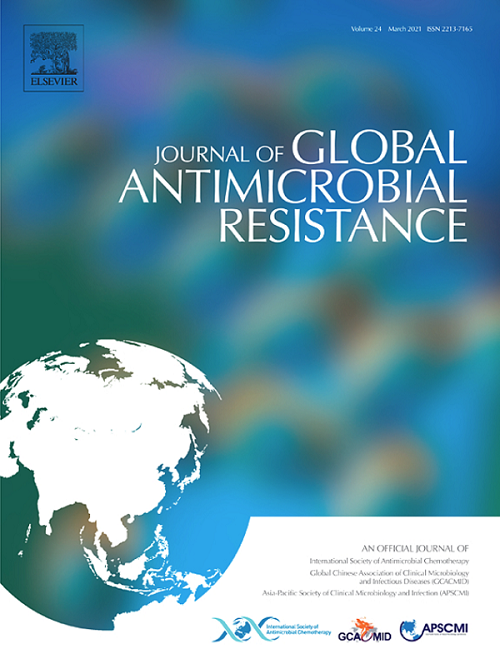CC5 MRSA isolates from goats and the farm environment are phylogenetically linked to isolates recovered from human clinical samples
IF 3.2
3区 医学
Q2 INFECTIOUS DISEASES
引用次数: 0
Abstract
Objectives
Despite MRSA's zoonotic nature, studies demonstrating the phylogenetic relatedness of animal isolates to other sources, including human clinical isolates, are scarce, especially in the Middle East.
Methods
We conducted whole genome sequencing (WGS) and phylogenetic analyses of clonal complex (CC) 5 MRSA isolates recovered from goats and their farm environments in Saudi Arabia and isolates recovered from other sources worldwide.
Results
MRSA isolates belonging to sequence type (ST) 6 recovered from goat nasal swabs and farm soil were phylogenetically related to MRSA isolates recovered from patients in Germany, Italy and the USA. Another isolate (ST5) from the goats’ milk was phylogenetically related to isolates recovered from the same hospital in Italy as the isolates belonging to ST6. The ST5 isolates from the goat’s nasal swab and drinking water were closely related to an MRSA isolate recovered from cheese in Austria and from patients in the USA. We found that there was a strong to moderate link of transmission of isolates belonging to CC5 from the USA to Saudi Arabia (ST6 Posterior Probability (PP) = 0.975, Bayes Factor (BF) = 179 and ST5 PP = 0.409, BF = 7). In addition, we found a moderate link of transmission from Germany (ST6 PP = 0.679, BF = 9) and Italy (ST6 PP = 0.489 BF = 4 and ST5 PP = 0.593 BF = 16). Although only seven MRSA isolates were detected, their close phylogenetic relatedness to human clinical isolates supports potential epidemiological significance and warrants further investigations.
Conclusions
MRSA isolates recovered from goats were phylogenetically related to isolates known to cause infections in humans in the USA and Europe.
从山羊和农场环境中分离的CC5 MRSA与从人类临床样本中分离的MRSA存在系统发育上的联系。
目的:尽管MRSA具有人畜共患的性质,但证明动物分离株与其他来源(包括人类临床分离株)的系统发育相关性的研究很少,特别是在中东地区。方法:对从沙特阿拉伯山羊及其农场环境中分离的克隆复合体(CC) 5 MRSA分离株和从世界其他来源分离的MRSA分离株进行了全基因组测序和系统发育分析。结果:从山羊鼻拭子和农场土壤中分离的序列型(ST) 6型MRSA与从德国、意大利和美国患者中分离的MRSA具有系统亲缘关系。从羊奶中分离出的另一株分离物(ST5)与从意大利同一家医院中分离出的分离物(与属于ST6的分离物)在系统发育上相关。从山羊鼻拭子和饮用水中分离出的ST5菌株与从奥地利奶酪和美国患者身上分离出的MRSA菌株密切相关。我们发现CC5分离株从美国传播到沙特阿拉伯存在很强到中等程度的联系(ST6后验概率(Posterior Probability, PP)= 0.975,贝叶斯因子(Bayes Factor, BF)=179, ST5 PP=0.409, BF=7)。此外,我们还发现来自德国(ST6 PP=0.679, BF=9)和意大利(ST6 PP=0.489 BF=4, ST5 PP=0.593 BF=16)的中度传播联系。虽然仅检测到7株MRSA分离株,但它们与人类临床分离株的密切系统发育相关性支持了潜在的流行病学意义,值得进一步调查。结论:从山羊中分离出的MRSA与美国和欧洲已知引起人类感染的分离株在系统发育上相关。
本文章由计算机程序翻译,如有差异,请以英文原文为准。
求助全文
约1分钟内获得全文
求助全文
来源期刊

Journal of global antimicrobial resistance
INFECTIOUS DISEASES-PHARMACOLOGY & PHARMACY
CiteScore
8.70
自引率
2.20%
发文量
285
审稿时长
34 weeks
期刊介绍:
The Journal of Global Antimicrobial Resistance (JGAR) is a quarterly online journal run by an international Editorial Board that focuses on the global spread of antibiotic-resistant microbes.
JGAR is a dedicated journal for all professionals working in research, health care, the environment and animal infection control, aiming to track the resistance threat worldwide and provides a single voice devoted to antimicrobial resistance (AMR).
Featuring peer-reviewed and up to date research articles, reviews, short notes and hot topics JGAR covers the key topics related to antibacterial, antiviral, antifungal and antiparasitic resistance.
 求助内容:
求助内容: 应助结果提醒方式:
应助结果提醒方式:


